Japan: guided walks travel the paths of the shoguns
A guided walk on the picturesque Kiso Road takes participants on a journey into Japan’s past.
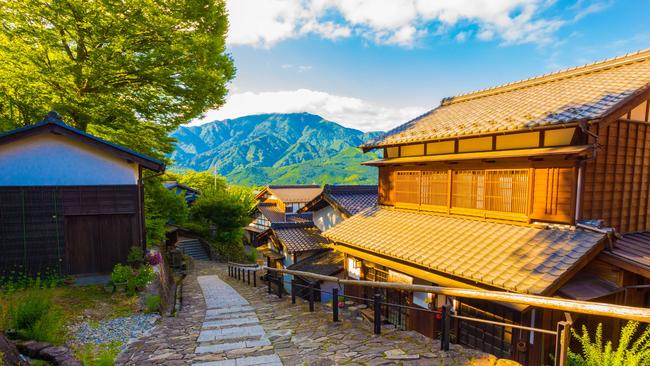
It seems impossible that last night we were stumbling through the neon frenzy of Tokyo’s Kabuki-cho. Now we are in Ena, a tiny town a few hours from the capital via Nagoya, where we have met our Walk Japan group. The wooden-walled ryokan we are sleeping in tonight has been here since 1624, and the three women looking after us are the 14th, 15th and 16th-generation innkeepers.
Ena was one of the 69 post towns of the Nakasendo, an ancient road connecting Kyoto with Edo, modern Tokyo. One of the five highways, or gokaido, that took on huge importance during the Tokugawa shogunate, the Nakasendo is now a road into Japan’s past. It’s 150 years since the Meiji Restoration brought to an end the fascinating Tokugawa era and 260 years of peace and unity, paradoxically under a military dictator and a restless warrior class, that followed 150 years of continuous civil war. This hard-won peace did not keep itself, of course.
As shogun, Tokugawa Ieyasu — the third and savviest of Japan’s Three Unifiers, after Oda Nobunaga and Toyotomi Hideyoshi — kept his daimyo or lords under control through the ingenious sankin kotai system. The lords spent alternating years in Edo, leaving their wives and children as hostages in the capital when they returned to their own domains. This had no real purpose other than to drain the lords’ resources while giving them a strong disincentive to rebel.
It also necessitated good roads to and from Edo and the creation of numerous post towns to supply them and their retinues. This is why we find ourselves in Ena, about to walk a surviving rural section of the Nakasendo called the Kiso Road, through the scenic Kiso Valley in central Honshu.
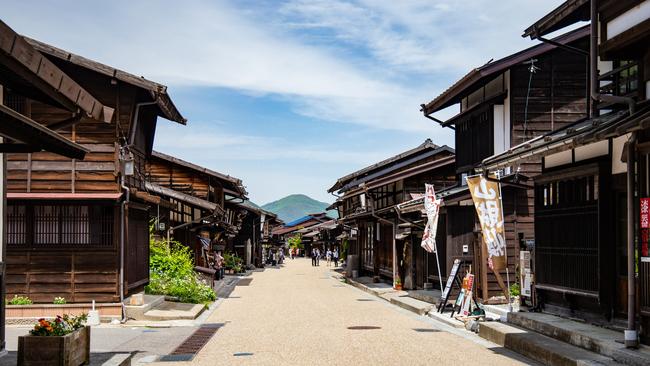
This five-day tour is a short one for Walk Japan, which leads tours all over the country from Hokkaido to Okinawa, including an onsen trail, winter snow-shoeing, a temple pilgrimage, and an 11-day Nakasendo walk that goes all the way from Kyoto through Hikone, Sekigahara (site of the conclusive battle won by Tokugawa in 1600) and several historic post towns to finish at Nihonbashi in Tokyo, the bridge to which all roads led.
Our group of 11 walkers — a family of four from New York, three New Zealanders, a mother and daughter from Melbourne, and my partner and I — is lucky to have as our tour leader Llewellyn Thomas, the managing director of Walk Japan. The unassuming Englishman is immensely experienced, funny and full of stories both droll and dreadful. (It being Japan, about half of them end with “ … and was compelled to commit suicide”.)
You can do this walk on your own, but the value of a guide can’t be overstated. Having a fluent and chatty Japanese speaker who gets stories out of everyone and sees beyond the surface of things makes the experience much richer and more immersive.
At Ena, we visit a museum dedicated to artist Utagawa Hiroshige, who evocatively, and sometimes imaginatively, captured some of the scenery we are about to see. There is a huge private collection of prints, plus a printing set-up that allows us to try our hand. We leave with some smudgy approximations of ukiyo-e masterpieces and a renewed respect for the craft.
Back at Ichikawa ryokan, bathed and in our yukata robes, we have our first kaiseki dinner, a succession of small, exquisite dishes — usually including salmon or ayu, a local river trout, seasonal vegetables, soba noodles, miso and pickles — with lashings of beer and sake. Breakfast is just as opulent, minus the sake. Walking begins next morning, after a short train and taxi ride, at Ochiai. Takashi Miike’s incredibly violent film 13 Assassins is set here, but there’s no mud or flying heads today. It’s late May, the end of spring; the last cherry blossoms have fallen and the countryside has burst into green. We pass small farms and rice paddies that reflect the sky; wildflowers bloom by the road; it’s warm but not yet humid, and utterly serene.
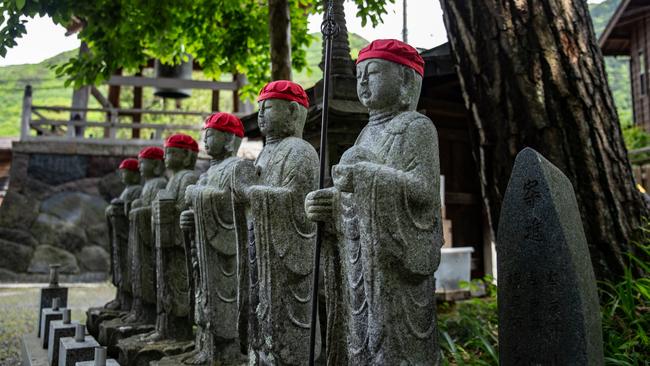
Writers in the 17th century described highways teeming with palanquin bearers and retainers, the air ringing with the cries of hawkers. Thomas asks us to picture the princess Kazunomiya travelling from Kyoto to Edo in 1861 to marry the 14th shogun, Tokugawa Iemochi, with a combined escort of about 25,000 retainers, plus some diabolically heavy luggage. Today we are almost alone on this narrow road, except for a fit older gentleman we meet perusing an information board. He mentions, offhand, that he has already walked the Nakasendo from Tokyo to Kyoto (about 500km) and is on his way back. He tells us he is 77.
Humbled, we make our way to Magome, a beautifully preserved post town of dark cypress buildings, swallows nesting in the eaves. This is the childhood home of Toson Shimazaki, author of the bleak realist novel Before the Dawn, set during the turbulent transition out of the feudal period. After lunch — this is soba noodle country — we pass a kosatsuba or board carved with Edo-period edicts such as the prohibition on Christianity and the rewards (handsome) for denouncing practitioners, and penalties (severe) for cutting down valuable cypress trees.
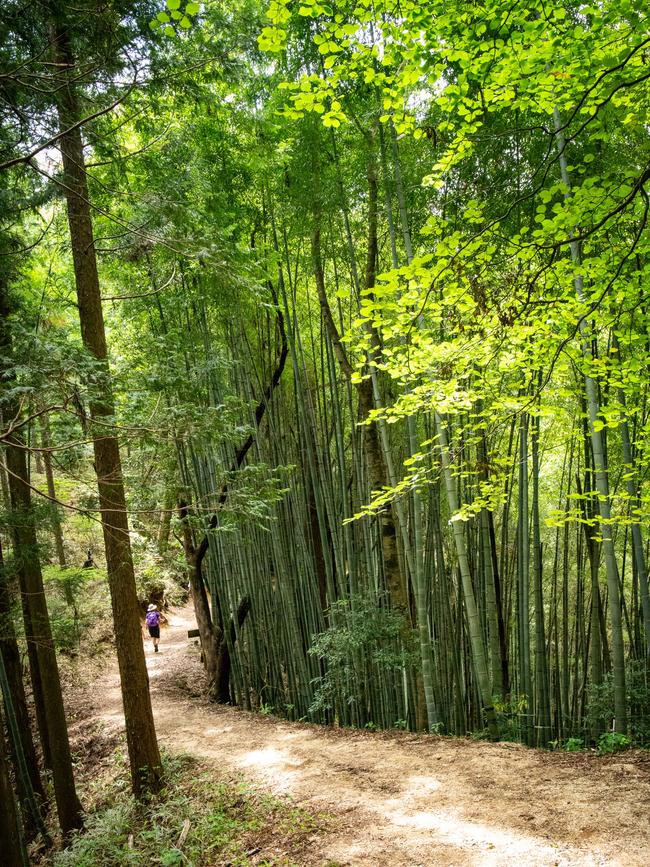
We walk over the Magome Pass, with mountain views and into forest, where the concept of shinrinyoku, or forest bathing, suddenly makes perfect sense. We take a short detour to the Odaki-Medaki (men’s and women’s) waterfalls, where legend has it two historically important cold showers were taken, and forest bathing takes on another meaning again.
Our next lodgings are in O-Tsumago (the O prefix denotes big, a joke at the expense of this micro-village) at Maruya ryokan, dating from 1789. After another superb dinner, we have our first communal bathing experience at a mountain onsen about 15 minutes away by bus. The weirdness of getting naked with new acquaintances evaporates immediately, and sliding out of the cold mountain air into steaming water, frogs croaking around us in the dark, feels perfect.
On day three we head off early and beat the crowds to Tsumago, another incredibly photogenic post town, where we visit the preserved waki-honjin — the second-most important inn — its cypress rafters black with the soot of centuries. Taking a slight detour, we walk over the Jizo Pass through wisteria-laden forest, clapping to warn off bears (rare but not unknown), and past the lovely Karasawanotaki falls. A mid-afternoon pause for tea and cakes at the cafe Kaida no Poppoya gives us our best view yet of Japan’s largest volcano after Mount Fuji, the sacred Mount Ontake, which erupted in 2014 and killed 63 people. The spectacular mountain view is, however, thoroughly upstaged by the irrepressible proprietors, Ando Hideji and Mitsuko, who keep a large model train set in their backyard and give a warm musical welcome to all Walk Japan guests. Descending to the town of Kisofukushima, we come to a barrier station, the kind through which all travellers in the Edo period had to pass. Travel was all but forbidden for commoners and for women, who might be wives of daimyo trying to flee the capital. To prevent this, any insufficiently masculine-looking man would be taken into a private room to have his credentials checked.
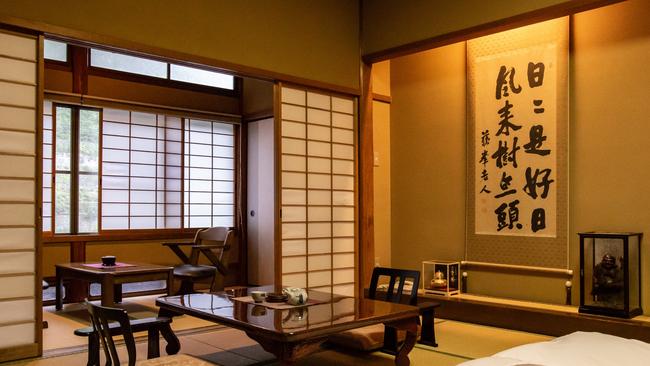
We stay at the palatial Iwaya ryokan in Kisofukushima, which boasts 11 imperial visits in its 300-year history, although the current building is a mere 90 years old. On day four we stop at Yabuhara shrine, dating from the seventh century AD. We catch the young shrine keeper on a visit home; he is based in Paris, where he educates Europeans about Shinto and, incredibly, is the 25th generation of his family to hold the inherited position.
Over the Torii Pass, under bright blue skies, we descend to Narai, another post town where long eaves tell us we have crossed the mountains into a region of heavy snows and torrential rains. We have some time to poke around (the area specialises in lacquerware and fine combs; one 88-year-old artisan comb maker has a full head of dark, wavy hair that proclaims the benefits), then it’s onwards by rail to the pleasant city of Matsumoto.
Spending our last night at a modern hotel, we are woken early by the announcement that the next-door restaurant is on fire. After a couple of hours on the street in our pyjamas watching the futuristically silver-coated firemen do their work, and being interviewed by local press, normal service is resumed. The hotel is untouched but the restaurant is gutted. I mention this only for the impeccable way the emergency is handled by everyone, not least our unflappable tour leader, and because it makes us reflect on the extraordinary survival over centuries of the many wooden buildings we have admired and slept in.
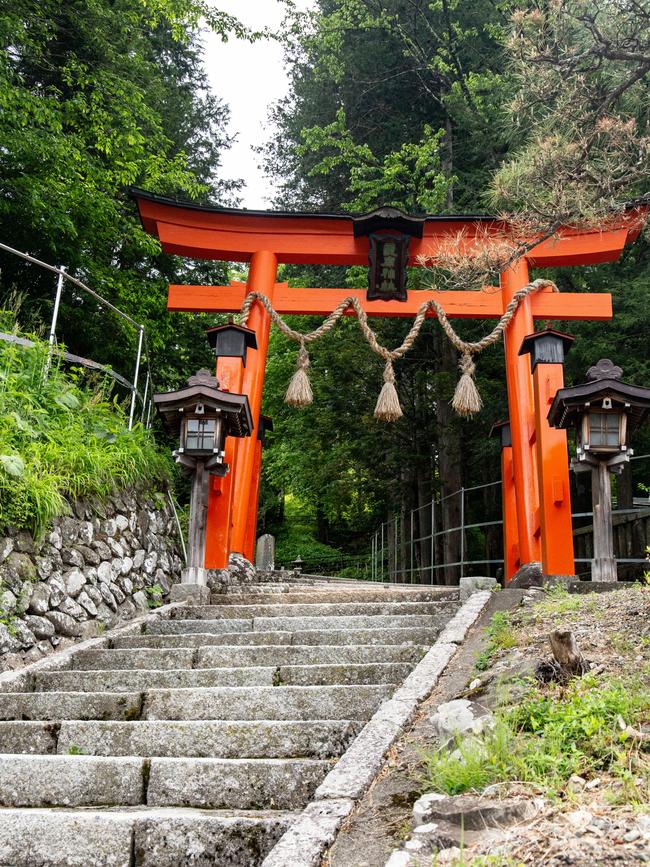
Our last wooden building is the imposing Matsumoto-jo, one of just four original castles in Japan to survive without rebuilding. Called Crow Castle for its menacing black aspect, it is a thing as much of beauty as military ingenuity, nothing like the stone hulks of Europe. As we squeeze up the tight cypress staircases to inspect the armoury, pursued by a pack of schoolchildren, we’re struck by the absurd fact that the average fearsome samurai was a diminutive 1.5m tall. We complete our tour at the local art gallery and a retrospective of the work of the city’s famous daughter Yayoi Kusama. It feels like a slingshot back to modernity; yet while her pumpkins seem worlds away from Hiroshige’s woodblocks, both are interpretations of the nature we have just walked through, and thus make perfect bookends to our journey.
Penny Durham was a guest of Walk Japan.
-
IN THE KNOW
The Kiso Road walk is offered from spring to autumn, starting at Y216,000 ($2660) a person, with a six-night version over winter (from Y304,000). The 10-night Nakasendo walk is offered from spring to autumn (from Y484,000).
-

MORE TO THE STORY
This is no gruelling hike; we walk with day packs, as luggage is sent ahead. In the pre-tour information pack, you are nonetheless asked to pack light. If travelling as a couple, put everything you need on the walk in one case. Walking is leisurely, about 12km a day with some gentle ascents and descents, and unless you have compromised knees you won’t need poles.
Guestrooms are booked as singles and doubles, perplexing as that is to the innkeepers, since Japanese tend to bunk down many to a room. Some have private toilets, some communal, and bathing is done in the evening, either by turns or all at once, separated by gender.
You’ll be drilled in the rules: wash first, then soak; nothing goes in the bath but yourself; tattoos are banned or at least must be covered up (it’s a yakuza thing). Footwear is the other main source of potential faux pas; don’t be the person who wears toilet slippers to dinner.
Futon mattresses were de rigueur in Australian share-house bedrooms in the 1990s, but those were bouncing castles compared with some of the authentic Japanese bedding we encounter, so if you’re bony or otherwise hard of sleeping, pack an inflatable pillow or two. Almost every meal is included, with booze paid for at the end. Japan has little truck with Western food fads, but two of our group who prefer to avoid red meat and raw fish respectively are catered for.


To join the conversation, please log in. Don't have an account? Register
Join the conversation, you are commenting as Logout